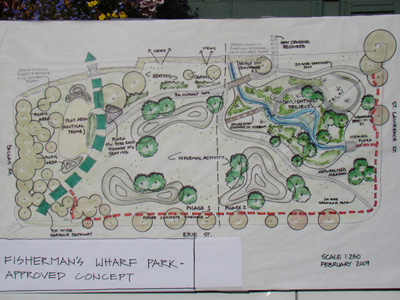Sep
29
New Look for an Old Park
Sep 2009
By Josie Bannerman
Work began in September on Phase 1 of the re-development of Fisherman's Wharf Park in the northwest corner of James Bay. What has been primarily a sports field will be transformed over the next six months into a place where people can wander through natural areas, or sit quietly and appreciate views of the harbour.
"This 4.69 acre park is the third largest in James Bay," said Janis Ringuette, chair of the James Bay Neighbourhood Association's (JBNA) Parks Committee. "It has great potential, yet has been sadly neglected for years. Our committee is pleased that the park will be improved. This is definitely the big park project in James Bay right now."
The City developed its vision for the new park with input from residents, businesses and non-profit groups, and intends to create a park that provides a place for recreation, inspiration and refuge for both locals and visitors. New elements will include more pathways, seating and gathering spaces; informal play spaces and development of a playground and plaza.

Ironically, with all the people these new amenities will attract, the vision doesn't spring for a public washroom. "We have 17 public washrooms in the park system," said Gary Darrah, the City's Manager of Park Planning and Design, "and we have a hard time maintaining these with our current budget and staffing levels. Concerns about security and vandalism increase the workload," he adds. "But in a few years, depending on budget and staffing and public demand, we might put one in," Darrah said.
The most dramatic change to Fisherman's Wharf Park could involve daylighting a creek, which years ago ran through the east side of the park into Heron Cove, and now lies buried in a municipal storm drain.
The idea to daylight the creek came from local residents, but Darrah said the City is still considering this potential Phase 2 project from a feasibility point of view. "The original streambed is 20 feet underground. Removing all the soil to get down there is expensive, but it has to be done or the water won't flow," he said.
Spiraling costs due to environmental considerations could also put a stop to the daylighting project, and consultants are still testing soil samples to ensure there are no issues from a public health standpoint. Darrah said there may be hydrocarbons in the soil, leftovers from the 1940's, 50's and 60's when the park was used as a dump. If contamination levels are high but the soil can be treated on-site, the expense will be much less than if the contaminated soil must be disposed of off-site. "If daylighting the stream doesn't turn out to be feasible, we may go back to the residents to ask for their input in deciding what should be done with the eastern end of the park," said Darrah.
JBNA chair, Tim VanAlstine expresses hope that the daylighting project will get the go-ahead once all the tests results have been analyzed. "If the City is able to go ahead with it," he said, "it would benefit us enormously by bringing the marine environment back into the community as it once was."
